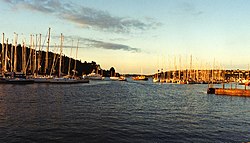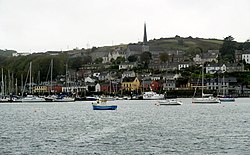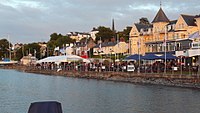Crosshaven
| Crosshaven Irish: Bun an Tábhairne | |
| County Cork | |
|---|---|
 Crosshaven | |
| Location | |
| Grid reference: | W792606 |
| Location: | 51°48’7"N, 8°17’43"W |
| Data | |
| Population: | 2,577 (2016) |
| Local Government | |
Crosshaven is a village in County Cork, standing at the mouth of the River Owenabue on the shore of lower Cork Harbour, across from Currabinny Wood.
Originally a fishing village,[1] from the 19th century, the economy of the area became more reliant on a growing tourism industry.[2]
Name
The modern Irish language name for Crosshaven village is Bun an Tábhairne. While some sources link the word tábhairne to the English word "tavern", other sources suggest that it is a corruption of "tSabhairne" a grammatical form of the word "Sabhrann" the name of a local river. Bun refers to "river mouth" when in reference to placenames. Therefore, the name is potentially translated to 'Mouth of the River Sabhrann', or 'Mouth at the tavern. The old Irish name for the east side of the village was Cros tSeáin or "John's Cross", and the English name derives from this.[3] John's Cross refers to the Norman castle built around Castle Point.
History
Crosshaven was originally a Viking settlement, part of what was known as the 'Ostman's Tancred', after Cork city became a fortified English stronghold.[4]
According to local folklore, Sir Francis Drake sailed up the River Owenabue, to conceal his ship from the Spanish Armada. A point in the river where he is alleged to have hidden is known as Drake's Pool. The historical impossibility of the incident should not spoil a local legend.
The local secondary school, Coláiste Mhuire, was founded by an aunt of James Joyce,[4] and the town is mentioned twice in Joyce's novel Ulysses.[5]
Nearby coastal artillery and military forts, Fort Templebreedy and Camden Fort Meagher, were built to defend the harbour, and after the creation of the Irish Free State they were retained by Britain as part of the Treaty Ports, until these were relinquished in 1938. Camden stands on the headland of Rams Head and is occasionally open to the public.[6]
Economy and tourism
Originally a fishing village,[1] in the late 19th and into the 20th century, tourism became important to the town,[2] which has five beaches within a two-mile radius. The area saw an increase in holiday homes in the mid-20th century, accommodating families from Cork city who stayed locally in the summer months. Some of these temporary cabins were initially built using very large packing crates from the Ford factory in Cork, and known as ‘Ford Boxes’.[7][8]
Tourism attractions in the town included Piper's funfair (known as "the merries"), a nightclub called The Majorca (now closed), a cinema (also since closed), and the Cockleshell (now an arcade called La Scala). Today Crosshaven is becoming a commuter town for Ringaskiddy and Cork.
In the 1970s and 1980s, environmental concerns came to the fore as a large industrial estate was built across the river in Ringaskiddy. It has provided a location for Pfizer and GlaxoSmithKline and other pharmaceutical companies.
Sport
The village is home to Royal Cork Yacht Club which has had its headquarters in the village since 1966. The club was established at the Cove of Cork (now Cobh) in 1720 and holds the title of the oldest in the world, according to the Guinness Book of World Records. In 1966 the club merged with the Royal Munster Yacht Club and made the Royal Munster's club house its headquarters. The biennial Regatta of Cork Week (formerly Ford Cork Week due to the sponsorship of the Ford Motor Company) draws many competitors and upwards of 15 thousand spectators to each competition.
- Athletics: Crosshaven Triathlon Club
- Football: Crosshaven AFC (one of the oldest football clubs in Cork, founded in 1898)
- Gaelic Athletics: Crosshaven GAA
- Rugby: Crosshaven RFC, founded in 1972
Outside links
| ("Wikimedia Commons" has material about Crosshaven) |
References
- ↑ 1.0 1.1 Samuel Lewis (1837). "Crosshaven". A Topographical Dictionary of Ireland. http://www.libraryireland.com/topog/C/Crosshaven-Kerrycurrihy-Cork.php.
- ↑ 2.0 2.1 Kieran McCarthy, Daniel Breen (2014). Cork Harbour Through Time. Amberley Publishing. ISBN 9781445634265. https://books.google.com/books?id=YCBVBQAAQBAJ&q=ford+crates+cork+crosshaven&pg=PT129.
- ↑ Cite error: Invalid
<ref>tag; no text was provided for refs namedlog - ↑ 4.0 4.1 "Breath taking crosshaven". Cork Independent. 18 August 2011. http://www.corkindependent.com/20110818/news/breath-taking-crosshaven-S3812.html.
- ↑ "A truly magical haven by the coast". Southern Star. 24 August 2014. http://www.southernstar.ie/News/A-truly-magical-haven-by-the-coast-21082014.htm.
- ↑ "Rescue Camden | Fort Camden, Crosshaven, Co. Cork". Rescuecamden.ie. http://www.rescuecamden.ie.
- ↑ "Tight squeeze for summer property in Graball Bay". Irish Examiner. 7 July 2007. http://www.irishexaminer.com/property/tight-squeeze-for-summer-property-in-graball-bay-36670.html.
- ↑ "Ford Boxes". Evening Echo. December 2005. http://www.bikvanderpol.net/archive/DOC/FordBoxInsert.pdf.

